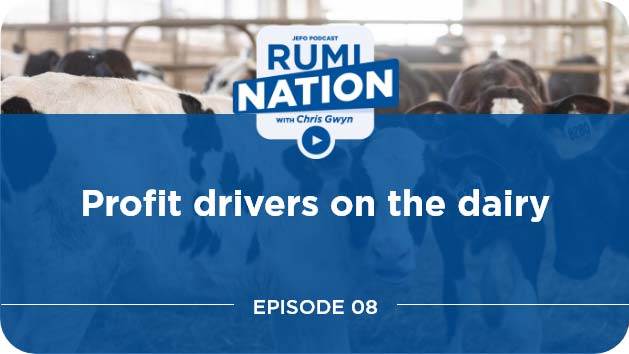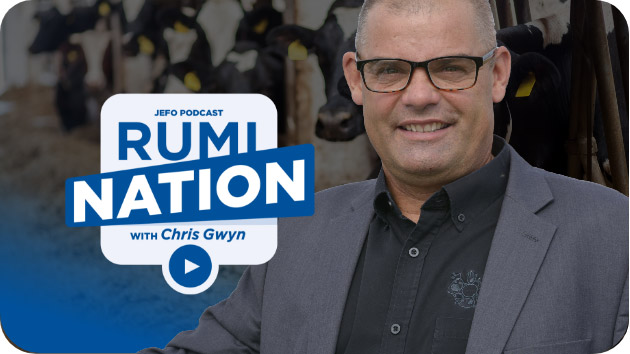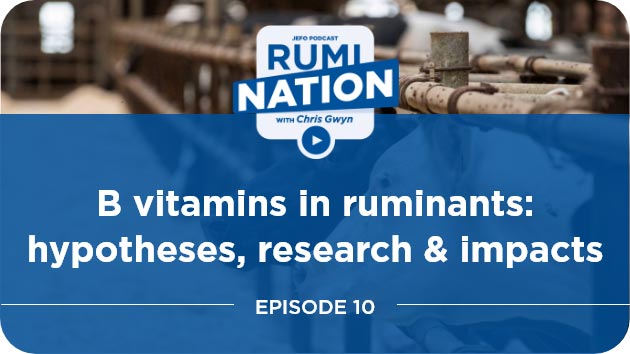RumiNation | S02 : E09
Using Nutrients as Medicine for Dairy Cows
Brought to you by Jefo Nutrition
Share now!
Did you enjoy this episode?
Share now!
Using Nutrients as Medicine for Dairy Cows
What is nutrition 2.0? How could a strategic use of nutrients reduce disease incidents, improve reproductive success, and give carryover milk benefits on dairy farms?
Learn more about nutrients as medicine with Dr. Barry Bradford.
Our guest - Dr. Barry Bradford
Dr. Barry Bradford completed a doctorate in animal nutrition at Michigan State University and served at Kansas State University for 13 years. In 2020, he returned to Michigan State University as the Clint Meadows Chair in Dairy Management. His research focuses on dairy cattle nutrition and metabolism, with a particular emphasis on attempting to translate novel findings in fundamental metabolic physiology to practical applications in animal agriculture.

Timestamps & Summary
01:10:00 – Your shared with me a paper you wrote in 2016 that talked about the nutrition 2.0. Can you explain a little bit more of what you mean by it?
We’re referring to a new generation of understanding nutrients and how we should feed them. With the discovery in the Human Genome project that there are hundreds of sensors in the genome that are apparently designed to sense nutrients and change cell function depending on the concentration of nutrients, we now have a whole different way that nutrients can affect the body. The new factors just open up a whole different way of thinking about using nutrients to change animal biology.
03:04:00 – Can you expand a bit more on some specific examples of nutrients that might impact cellular function?
Every single class of nutrients, minerals, vitamins, proteins, carbohydrates have this potential effect. One that we could dig into a little bit is beta hydroxybutyrate. It’s a metabolite that we’re really interested in, and it’s what gets elevated during ketosis. Dr. Bradford explains how it impacts the cows, and the studies in progress about it.
05:22:00 – How could dairy producers utilize those concepts or how should they be thinking about it?
Dr. Bradford explains that the shifts in weather patterns are explored, along with how we could adapt the minerals fed accordingly. There may also be nutritional strategies that could be applied to target fresh cows and high-risk cows instead of the whole herd.
Folic acid is a neat example of a nutrient that has great effects, as studies on mice showed that males that are folic acid deficient will actually confer potentially birth defects on offspring.
What experts are working on now will change how we do things over the next number of years.
9:19:00 – How should nutritionists and dairy producers approach thinking about nutrition 2.0?
In a competitive commodity business like dairy, people are looking at every penny, and they have to. Focusing on transition cows is a good way to apply nutrition 2.0 principles, as we know from a lot of research that it can prevent major train wrecks for a 2-week window. The carryover benefits are massive.
We did a study where we fed a phytochemical intended to be an antioxidant and anti-inflammatory for just the first 60 days of lactation. The carryover effects lasted through 300 days of milk. If you do the math, it’s profitable. You actually reduce disease incidents, potentially improve reproductive success, and have carryover milk benefits.







